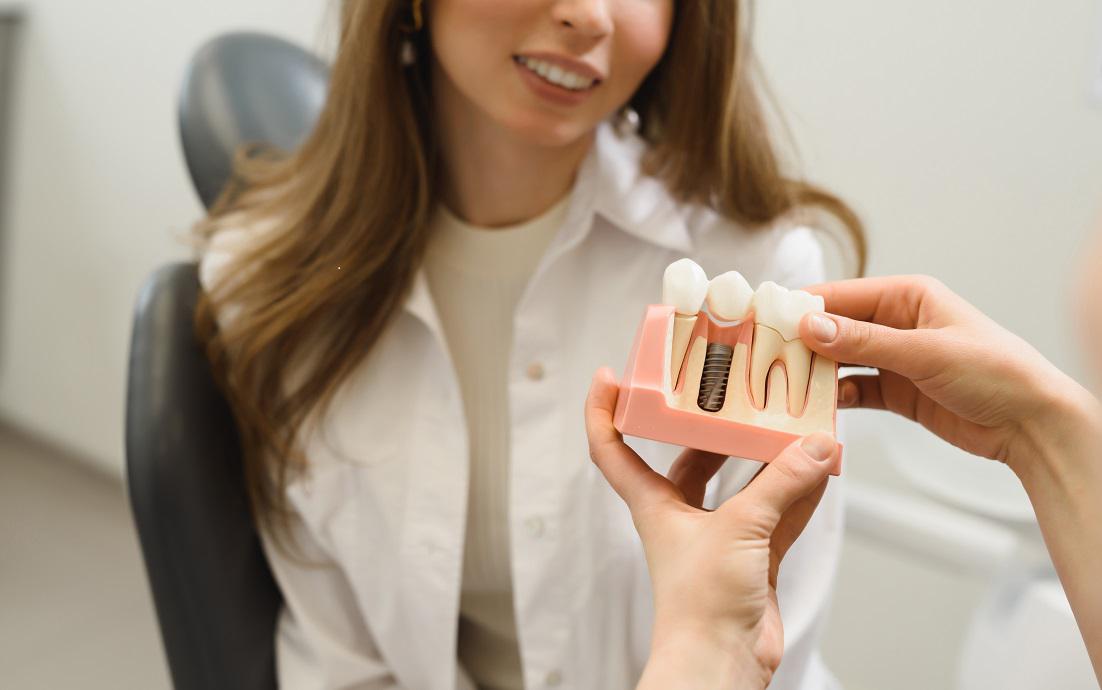 If you’re a victim of tooth loss, you may know that traditional bridges, partials, and dentures have long been the standard for tooth replacement. However, the replacement option that most imitates the natural design of teeth, with crown and root, is the dental implant. One implant can replace a single tooth, a few can anchor a bridge or partial, and four to six implants can secure a denture on the upper or lower jaw.
If you’re a victim of tooth loss, you may know that traditional bridges, partials, and dentures have long been the standard for tooth replacement. However, the replacement option that most imitates the natural design of teeth, with crown and root, is the dental implant. One implant can replace a single tooth, a few can anchor a bridge or partial, and four to six implants can secure a denture on the upper or lower jaw.
Implants, though often covered by insurance, are costlier than traditional dental prosthetics. So why should you consider dental implants over the tried-and-true tooth replacement options? Implants offer quite a few benefits. In fact, according to NCBI, 450 thousand dental implants are placed annually, and they have a 95% success rate.
In this article, we’ll explore the top three reasons you should include implants among your options for tooth replacement.
Comparing Implants to Traditional Dental Prosthetics
First, you need to understand how bridges, partials, dentures, and dental implants work.
Dental Bridge (AKA Crown and Bridge or Bridgework)
Bridges replace one tooth or a few teeth in a row. A bridge consists of one crown, one or more pontics (false teeth), and another crown. The replacement teeth form a literal bridge between the crowns.
First, a tooth on either side of the missing tooth/teeth are prepared to receive crowns. Preparation involves shaving down these healthy teeth so they can accommodate crowns. Next, the crowns of the bridge are secured with permanent dental cement.
Bridges are not removable. They can last 5 to 15 years in patients with good oral health and regular dental hygiene, and in the absence of accident or injury.
Partial (AKA Partial Denture)
Partials are similar to dentures in that they replace multiple teeth on the upper or lower arch. However, partials allow healthy teeth to remain intact. A partial features replacement teeth on a solid frame. The appliance fits much like a puzzle piece, with pontics fitting between natural teeth. Most often, partials clip to a few healthy teeth for stability.
Partials are removable, though they can be permanently secured if necessary.
Denture or Full Dentures
A denture replaces all teeth on the upper or lower arch. Full dentures replace teeth on both arches with two separate appliances.
Dentures are lined with a material that fits snugly against gum topography, the bumps and ridges on toothless gums. Upper dentures can be held in place with natural suction or adhesive. Lower dentures, most often, are secured with denture adhesive.
Over time, friction between denture lining and gums will wear gum tissue down, making it smoother. This causes a denture to feel loose and it may slip out of place, particularly when the patient is eating or speaking. Relining every one or two years helps a denture fit more snugly. However, once gums are rubbed smooth, denture retention can become an ongoing challenge.
Dental Implants
A dental implant’s structure consists of a prosthetic root, by way of a biocompatible, screw-like post, and a crown, which is the “tooth” part that you can see above the gumline. Between the post and crown, an abutment connects the two primary components. Thus, implants are independently anchored into the patient’s jawbone.
A single crown can be secured to one implant post, or a few implants can support a bridge, partial, or denture. Most patients with good dental health and sufficient jawbone density qualify for dental implants. When bone density is poor, bone grafts may make a patient eligible for implants. With good oral hygiene and health, dental implants can last a lifetime.
Denture patients who struggle with loose, slipping dentures usually love dental implants. Attached to implants, dentures will not move a bit! Dental implants are permanent, and multiple-tooth prosthetics may be permanently secured upon request.
Top Reasons to Consider Dental Implants over Traditional Dental Prosthetics
1. Dental Implants: The Most Conservative Tooth Replacement Option
Though implant placement requires a brief outpatient surgery, implants are considered more conservative than traditional bridges, partials, or dentures. Each of these traditional prosthetics rely on existing biological structures for support: bridges and partials place additional burden on the teeth to which they attach, and dentures wear down natural gum ridges.
In contrast, implants simply take the place of missing teeth roots when inserted into empty sockets within the jaw.
Furthermore, jawbone tissue deteriorates when teeth roots aren’t present. Replacing natural teeth roots with implant posts re-initiates tiny vibrations in the jaw that tell the body the jawbone and teeth roots are being used and are necessary. The body begins to send important, bone-strengthening nutrients to the jaw again to retain solid jawbone density. Traditional dental prosthetics do not accomplish this, so the jawbone continues to deteriorate over time.
2. Dental Implants Can Last the Rest of Your Life
Though the crowns, bridge, partial, or denture attached to implant posts may need replacement if damaged or worn, the implant posts should last for the rest of your lifetime.
3. With Dental Implants, Care and Maintenance Are Simple
No messy adhesives, special soaking solutions, or new cleaning routines are necessary with dental implants. You’ll simply need to care for them as you should care for your natural teeth. Brush twice daily. Floss before evening brushing. Use an ADA-approved toothpaste and mouthwash. Attend six-month checkups and cleanings, and if you notice anything out of the ordinary, see your dentist.
Why You Should Seriously Consider Dental Implants for Tooth Replacement?
Easy care, lifelong service, and their conservative qualities make dental implants a smart choice for most patients. Ask our dental team for an exam to determine whether you qualify for implants.


